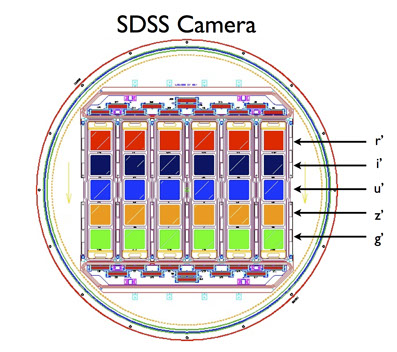The visible light we see with our eyes is part of a much larger continuous spectrum called electromagnetic (EM) radiation. Different categories of light (e.g., X-rays, Infrared, Radio), are defined by their wavelengths, with visible light ranging from approximately 400nm-750nm. The image and table below show which wavelength ranges in the electromagnetic spectrum correspond to which types of light.

| Type of Light | Wavelengths |
|---|---|
| Radio waves | > 30 cm |
| Microwaves | 1 mm – 30 cm |
| Infrared | 750 nm – 1 mm |
| Visible light | 400 nm – 750 nm |
| Ultraviolet | 10 nm – 400 nm |
| X-rays | 0.01 nm – 10 nm |
| Gamma rays | < 0.01 nm |
Filters are specially designed pieces of glass that only allow certain wavelengths of light to pass through to a camera’s detector. Astronomers use different combinations of filters to make color images of the sky and to precisely measure how bright various objects appear in different ranges of wavelengths. There are five different filters built into the SDSS camera. These filters are used to provide measurements of the brightness of objects in small wavelength windows, ranging from the near-ultraviolet to the near-infrared. Even though the type of filters used in SDSS capture a wide range of wavelengths, the principle behind capturing color images using every-day digital cameras, including the cameras on your mobile phone, is exactly the same.
Shown on the right are engineers placing a protective layer of glass on top of the SDSS camera filters. The engineers are dressed as though they are performing surgery. Like surgeons, they know that the quality of the operation depends upon steady hands and a clean environment. Dust and fingerprints can negatively affect the quality of the images taken by the camera.


Shown to the left is a diagram of the placement of the five filters that are overlaid on the SDSS camera’s detector. Each row is labeled with a letter indicating a particular filter.
u’ – ultraviolet light
g’ – blue and green visible light
r’ – yellow and red visible light
i’ – near-infrared light
z’ – near-infrared light
The SDSS camera is sensitive to light spanning the range ~300nm (near-ultraviolet) to ~1050nm (near-infrared). The image to the right shows generally where the window for each of the SDSS filters lies in the range of wavelengths that make up the EM spectrum. Three of the filters are outside of the range of visible light. The u’ (or ultraviolet filter) is just beyond the blue end of the spectrum. The i’ and z’ filters are just beyond the red.
Wavelengths are measured in units called Angstroms along the horizontal axis of the image to the right. One Angstrom is equal to one ten-billionth of a meter, or 10 nanometers. The largest number on the graph below is still far too small to be seen with a normal microscope.
The SDSS camera measures the amount of light passing through each filter. This information, the intensity of light transmitted at different locations along the electromagnetic spectrum, provides a powerful tool for astronomers to make careful measurements of the brightness and color of objects in the sky.

